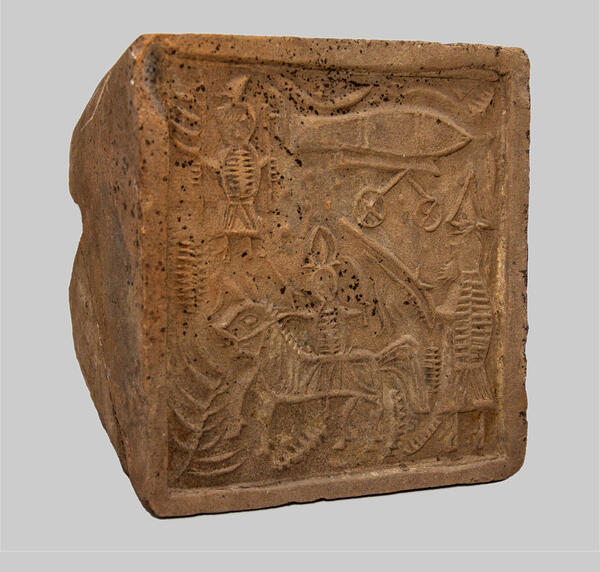Such relief terracotta or irrigation tiles were used to cover brick stoves, which were heated with a chimney. The smoke in these stoves came out through the chimney, so the rooms did not accumulate soot and smoke.
‘Tile’, or as it is also called ‘sample’ is a clay burnt tile, on the reverse side of which there is a tiller, or box – with its help, the tile is attached to the stove lining. They were widely used to decorate the interiors of homes in Tobolsk at the end of the 17th-18th centuries – this is evidenced by numerous archaeological discoveries.
The collection of red-terracotta-stove tiles is of great interest, which were especially popular from the end of the 16th century in Moscow, and later spread beyond the Muscovy, up to Siberia. The Museum’s collection contains several dozens of such exhibits. Most of the samples were not completely preserved, but in fragments, and archaeologists found only one whole tile.
According to research by historians, red tiles in Siberia have ceased to exist at the end of the 17th century. Initially, it was exclusively imported product. But, with the beginning of stone construction on the territory of the Tobolsk Kremlin, the city has its own tile production.
The tile from the Museum is most likely imported - this is evidenced by the peculiarities of the drawing technique and the traditional plots for Moscow and other cities of North-Eastern Russia. Or it was made in Tobolsk, but under the supervision of the craftsman of the “Moscow” school of the late 17th century. A slightly carelessly made image of soldiers with arquebuses, cannons, berdiches can be seen on the tile. The armour and helmets of warriors, as well as elements of horse harness, are made in more detail.
According to written sources, stone construction in Tobolsk has developed just under the “Moscow” influence. This is evidenced by the elements of architectural decoration. Undoubtedly, the preserved tile shows the high culture of ceramic production and the widespread use of this facing material in Russia at the end of the 17th–18th centuries.
‘Tile’, or as it is also called ‘sample’ is a clay burnt tile, on the reverse side of which there is a tiller, or box – with its help, the tile is attached to the stove lining. They were widely used to decorate the interiors of homes in Tobolsk at the end of the 17th-18th centuries – this is evidenced by numerous archaeological discoveries.
The collection of red-terracotta-stove tiles is of great interest, which were especially popular from the end of the 16th century in Moscow, and later spread beyond the Muscovy, up to Siberia. The Museum’s collection contains several dozens of such exhibits. Most of the samples were not completely preserved, but in fragments, and archaeologists found only one whole tile.
According to research by historians, red tiles in Siberia have ceased to exist at the end of the 17th century. Initially, it was exclusively imported product. But, with the beginning of stone construction on the territory of the Tobolsk Kremlin, the city has its own tile production.
The tile from the Museum is most likely imported - this is evidenced by the peculiarities of the drawing technique and the traditional plots for Moscow and other cities of North-Eastern Russia. Or it was made in Tobolsk, but under the supervision of the craftsman of the “Moscow” school of the late 17th century. A slightly carelessly made image of soldiers with arquebuses, cannons, berdiches can be seen on the tile. The armour and helmets of warriors, as well as elements of horse harness, are made in more detail.
According to written sources, stone construction in Tobolsk has developed just under the “Moscow” influence. This is evidenced by the elements of architectural decoration. Undoubtedly, the preserved tile shows the high culture of ceramic production and the widespread use of this facing material in Russia at the end of the 17th–18th centuries.



